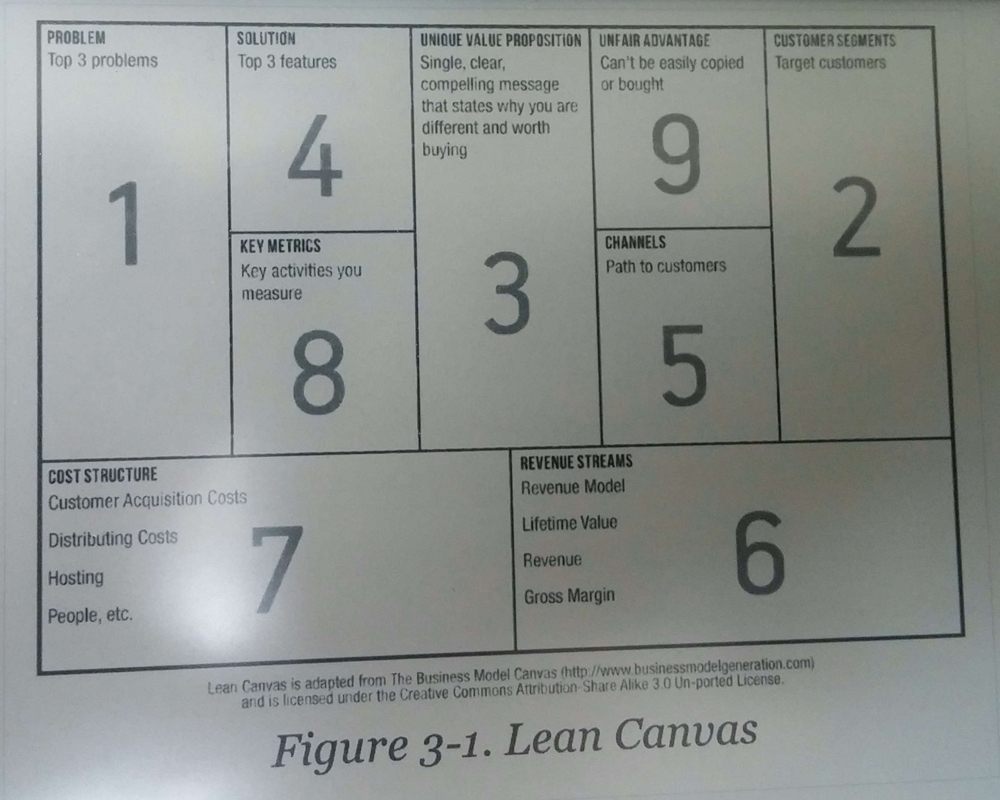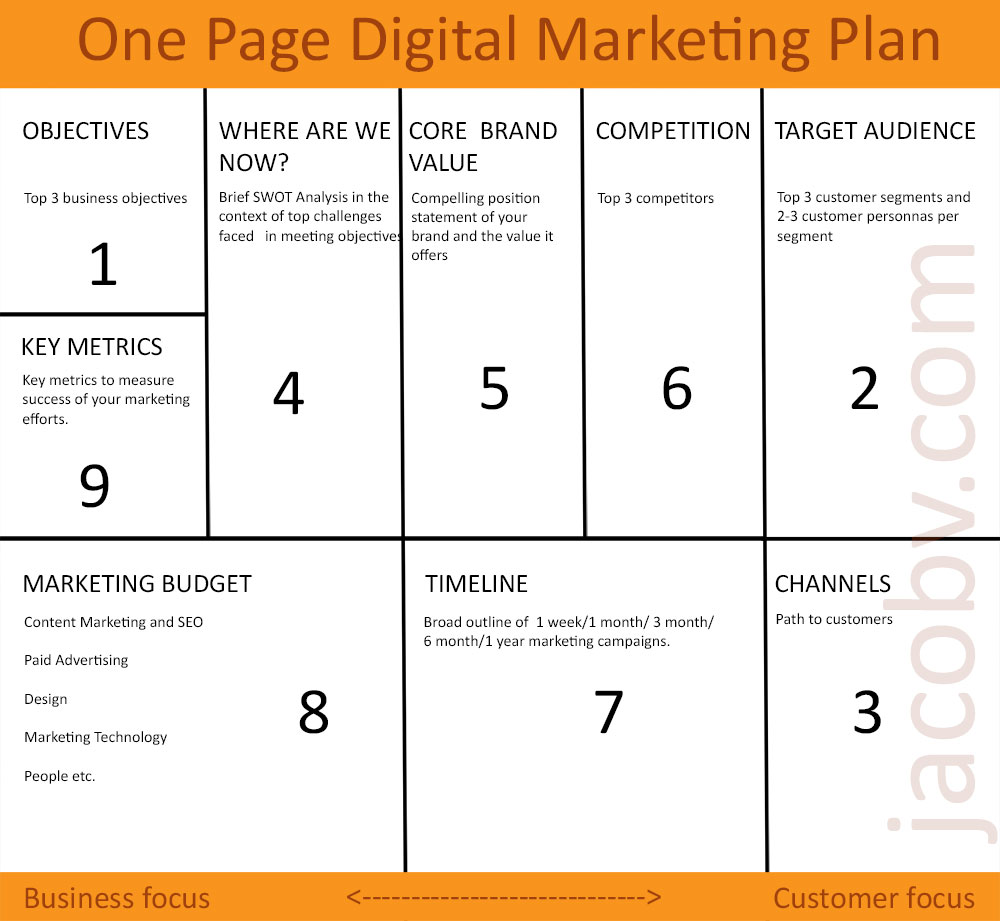Knowing where to start with their digital marketing efforts is a common problem among many small businesses.
Most know they should have a plan but few understand how to pull together seemingly mystical marketing tactics like SEO, social media marketing, content marketing, PPC, and everything else the gurus are constantly talking about.
On the other side of the coin, elaborate marketing plans are seldom referred to or updated beyond the initial exciting conception period.
Life’s too short to write stuff nobody reads.
As I do prep work on some startup ideas, I’m going through a bit of reading on the subject of bootstrapping. One such book revolves around the lean startup business plan.
Running lean by Ash Maurya offers a wealth of information on creating a one page business plan in as few as 20 minutes. Those interested can check out the app for the latest version of the one page business plan.
The marketing purists can disagree but if you replace ‘Business plans’ from the below statement with ‘Digital marketing plans’, you know that there is a need for a one page digital marketing plan too.
Business plans take too long to write, are seldom updated, and almost never read by others but documenting your hypotheses is key. – Leanstack.com
So I modified the above chart to create a one page digital marketing plan that would work for startups, lawyers, dentists, not-for-profits, and sundry small businesses in between.
Something for everyone in the one page digital marketing plan
This one page plan lends itself to adaptation and changes in keeping with the agile marketing methodologies of today.
The single-page layout could work as well for the next online webinar as it could for a broader influencer or content marketing campaign.
Marketing purists will take heart in the fact that each of the 9 elements can be elaborated on into voluminous chunks of any elaborate 500-page treatise.
At the same time, confused small businesses can use the one page digital marketing plan to put together a brief, highly flexible, customer-oriented document that meets their business objectives.
Download your copy of the One Page Digital Marketing template here. NOTE: Use File>Download As for your own copy
Download the Digital Marketing Plan Template - Google doc file
For those interested in further details about the 9 sections in the template:
1) OBJECTIVES
Start with your top 3 business objectives.
These business objectives should be measurable targets of business aims.
Here’s one article that elaborates on ‘How to define SMART marketing objectives’.
2) TARGET AUDIENCE
Top 3 customer segments and customer personas per segment.
This is one of the most important and, I tend to think, fun parts of the marketing plan. Deep diving to understand your customers better will focus your marketing efforts on optimal results.
Start this section with customer segmentation to ‘group’ your customers or potential customers in ways having the biggest impact on your business. Group your customer base into meaningful, measurable segments according to your research on customers’ needs, behaviors, and demographic profiles.
Then move on to creating two or more fictional characters for each of these customer segments. Here are some really good examples of customer personas.
The customer personas that you create should inform the kind of content you create online to attract similar customers to your digital assets.
3) CHANNELS
Document the online paths to your customers here. Your exercise at creating segments and personas will provide insights into where your customers live in the digital world.
My 17-year-old daughter has a single LinkedIn connection. Me.
Businesses using LinkedIn to target my daughter and her friends would be wasting time.
Snapchat marketing to try reach the c-suite of fortune 500 companies could be just as fruitless. Some channels may be more apt for your business than others.
Look for ways you can find your customers online.
4) WHERE ARE WE NOW?
Use this section to create a brief SWOT analysis of your current marketing status in the context of challenges faced in meeting business objectives defined in #1.
Do you have a responsive website? How are your SERPs for relevant keywords? Can your existing staff create the kind of content your customers will be interested in? What are the alternatives? Do you have the resources to maintain consistent activity across the social channels where your customers live?
5) CORE BRAND VALUE
Define the compelling position statement describing your brand and the value it offers.
This value proposition should be customer-centric and resonate with the customers you have defined in #2.
The brand value should also work across all the channels you have documented in #3.
6) COMPETITION
Research the top 3 competitors in your niche and dig out their strengths and weaknesses. Remember to keep the focus on the customer, refer to #2 and #3.
You should figure out what your competitor’s online weaknesses are when it comes to attracting and retaining customers.
e.g.:
- SERPs for keywords
- Blog activity
- Social media engagement across relevant channels
- Customer service
- Website UX
- Product strengths and weaknesses
7) TIMELINE
Define brief outlines of your 1 week/1 month/3 month/6 month/1 year marketing campaigns.
As I previously mentioned, the one page campaign can work for both small-term campaigns and long-term strategies.
Once you have put the effort into some of the sections like #2 & #3, the other sections can be tweaked as needed, for each weekly campaign or on a monthly or quarterly basis. Any updates should benefit from the results of your incremental learning experiences.
In this way, your one page plan accommodates a continuous experimentation-learning-feedback mechanism apt for the rapidly changing digital marketing environment.
8) MARKETING BUDGET
Wouldn’t it be great if you could do all this at the least expense possible? You can if you have attended to the previous steps with due diligence.
It’s time to put together the estimated costs to implement your digital marketing plan which includes.
- Content Marketing & SEO
- Paid Advertising
- Design
- Marketing Technology
- People
etc.
9) KEY METRICS
Here’s where you list KPIs that measure the success of your marketing efforts.
e.g.:
- eCommerce revenues
- Online Referrals
- Membership Renewals
Like many other marketers, I’m a fan of this Digital Marketing and Measurement Model by Avinash Kaushik. It even revisits some of the previous steps and if you have been thorough, it should be relatively easy to define your KPIs now.
That’s it. Off to the races!
p.s.: Digital marketer? Feel free to modify, elaborate or otherwise improve on the one page digital marketing plan, and do share your progress.
If you have the basics well covered you may want to start digging into how a go-to-market conversion tracking template could work for you.


